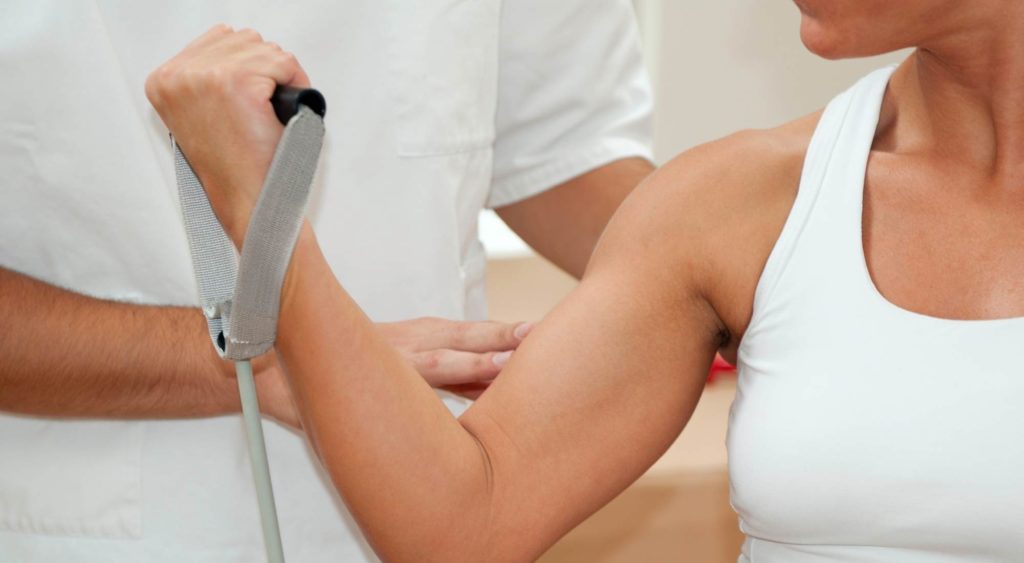Torn Biceps Tendon

Physical Therapy for a Torn Biceps Tendon – Information, Exercises, and More
Have you had pain from a torn biceps tendon?
It can negatively affect your day-to-day life.
Physical therapy can help speed the healing process and help you recover lost strength and mobility.
Keep reading to learn more about the symptoms and treatments of torn biceps tendon and the benefits of physical therapy.
Contents
- What Is Torn Biceps Tendon?
- What Causes Torn Biceps Tendon?
- Risk Factors for Torn Biceps Tendon
- Torn Biceps Tendon Symptoms
- Torn Biceps Tendon Diagnosis
- Torn Biceps Tendon Treatment
- Surgical Treatment
- Nonsurgical Treatment
- Can Physical Therapy Help Torn Biceps Tendon?
- Best Physical Therapy Exercises for Torn Biceps Tendon
- How In Motion O.C. Can Help With Torn Biceps Tendon
What Is Torn Biceps Tendon?
Your biceps tendons attach the biceps muscle to bones in your shoulder and elbow. A biceps tear is a strain or tear in the biceps muscle.
Biceps tendon tears can be partial or complete:
- Partial tears do not completely sever the tendon.
- Complete tears will split the tendon into two pieces.
In many cases, torn tendons begin by fraying. As the damage progresses, the tendon can completely tear.
What Causes Torn Biceps Tendon?
There are two ways to cause biceps tendon tears:
- Injury
- Overuse
Cause #1: Injury
You can tear your biceps tendon by falling with your arm outstretched. It can also be torn by moving or twisting your elbow or shoulder in an awkward way.
Biceps tendon tears at the elbow are often caused by lifting a heavy object — such as a couch or a refrigerator.
Cause #2: Overuse
Many biceps tendon tears are the result of a wearing down and fraying of the tendon. This happens slowly over time. It also happens naturally as we age.
You can worsen this natural wearing down by repeating the same shoulder motions again and again, causing overuse.
Shoulder problems such as …
- Tendinitis
- Shoulder impingement; and
- Rotator cuff injuries
… are caused by overuse and can lead to stress and tear of the biceps tendon.
Risk Factors for Torn Biceps Tendon
You may be more at risk for torn biceps tendon depending on these factors:
- Age
- Older people can be more at risk due to years of overuse.
- Heavy overhead activities
- Activities such as weightlifting can cause people to be more at risk. Those with jobs that require heavy overhead lifting can have more wear and tear on their tendons.
- Sports
- Sports such as swimming or tennis can cause more tendon wear and tear.
- Smoking
- Nutrition in the tendon can be negatively affected by nicotine use.
- Corticosteroid Medications
- Corticosteroids have been linked to increased tendon and muscle weakness.
Torn Biceps Tendon Symptoms
Symptoms of torn biceps tendon include:
- Sometimes an audible pop or snap
- Sudden, sharp pain in your upper arm
- Bruising from the middle of your upper arm down toward the elbow
- Cramping of the biceps muscle with strenuous use of your arm
- Weakness in your shoulder and elbow
- Tenderness and pain at the shoulder and elbow
- Difficulty turning your hand palm up or palm down
- Change in the contour of the front of your biceps (“Popeye muscle”)
Torn Biceps Tendon Diagnosis
Receiving a physical examination from your doctor is needed for diagnosis.
You’ll discuss your:
- Symptoms
- Lifestyle
- Habits; and
- Medical history
Partial tears are less obvious than complete tears. Your doctor may have you bend your arm and tighten the biceps muscle. Pain when doing this may indicate a partial tear.
Your doctor will also check for any other shoulder problems and damage to your elbow. Additional tests may be needed to help identify any further problems.
Your doctor will likely perform an ultrasound, in combination with an MRI and x-rays to rule out any other issues, such as a rotator-cuff tear.
Torn Biceps Tendon Treatment
Surgical Treatment
Surgery is rarely needed for biceps tendon tears, and is considered a last resort.
However, some people may benefit from surgery if they’ve developed cramping of the muscle or pain that can’t be relieved with nonsurgical options.
Also, those who need to ensure a complete recovery in strength, such as manual laborers and athletes, may benefit from surgery.
The goal of torn biceps tendon surgery is to re-anchor the torn tendon back to your bone. There are multiple surgery options that your doctor will discuss with you for your specific case if surgery is necessary.
After surgery, your doctor will soon start you on therapeutic exercise, such as physical therapy to help improve your range of motion and strengthen your shoulder.
Nonsurgical Treatment
Nonsurgical treatment options include:
- Ice
- Applying ice or a cold compress to the injury can be effective for alleviating pain and swelling.
- Nonsteroidal anti-inflammatory drugs (NSAIDs)
- Anti-inflammatory drugs can be useful for reducing pain and swelling.
- Rest
- Rest and avoiding activities that cause pain can help relieve pain and limit swelling.
- Physical therapy
- Physical therapy helps to restore movement and strength to your shoulder.
Can Physical Therapy Help Torn Biceps Tendon?
Yes, physical therapy for torn biceps tendon is recommended to help build strength and flexibility in your shoulder or elbow. Your commitment to physical therapy is the most important factor in returning to all the activities you enjoyed before your injury.
Best Physical Therapy Exercises for Torn Biceps Tendon
There are many exercises that your physical therapist may have you do during therapy and at home.
Some include:
- Biceps stretch
- Elbow flexion and extension
- Shoulder flexion
- Resisted shoulder internal rotation
- Resisted shoulder internal rotation
- Side-lying external rotation
We’ve outlined a few for you below.
Biceps Stretch
Stand in front of a wall with a 6-inch distance and raise your injured arm palm down, below your shoulder’s height. Keep your thumb on the wall and gently turn away from the wall, stretching your biceps as you move.
Hold for 15 seconds, keeping your arm straight. Repeat three times daily.
Elbow Flexion and Extension
Gently bend your injured arm and place your palm up to your shoulder. Now, put your hand down.
Repeat this 15 times for two sets. Do this exercise two times daily.
Shoulder Flexion
Raise your injured arm forward and up over your head. Hold this for five seconds and gently lower your arm down on your sides.
Do this eight to 12 times. Repeat two times daily.
How In Motion O.C. Can Help With Torn Biceps Tendon
In Motion O.C. can help you achieve your recovery goals after a torn biceps tendon through exercises and treatments tailored to your needs.
Our physical therapists have helped hundreds of people just like you recover from various ailments.
In Motion O.C. is #1 among physical therapists.
Let our therapists work with you one-on-one to determine the best approach for your recovery through customized physical therapy for torn biceps tendon.
The content in this blog should not be used in place of direct medical advice/treatment and is solely for informational purposes.



